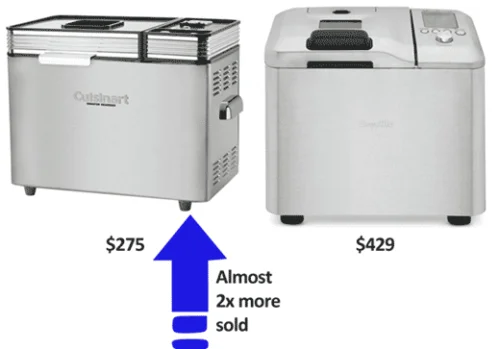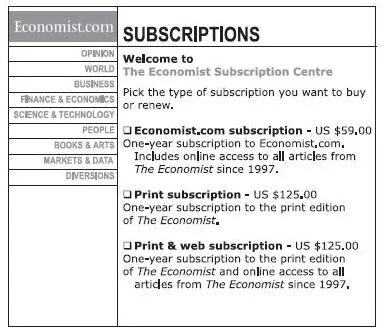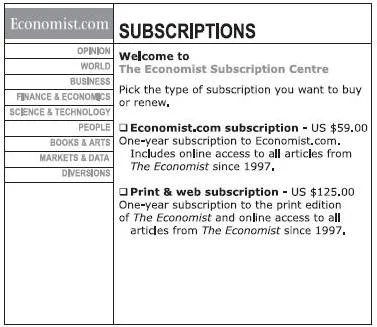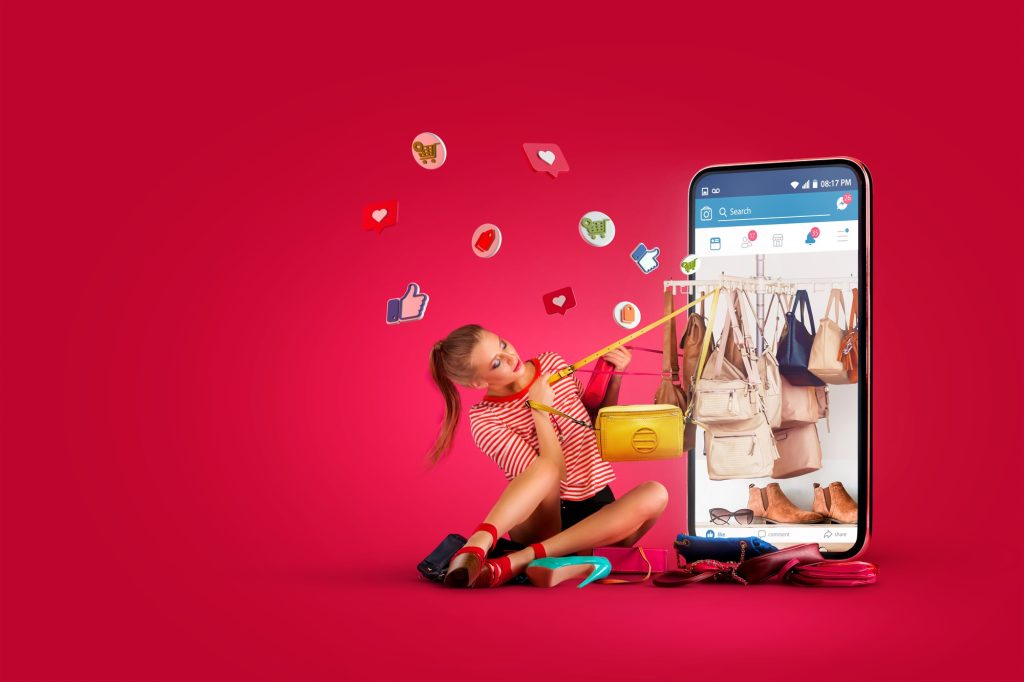Have you ever thought of making your product look worse to sell more?
Sounds counterintuitive for a product marketing strategy, right?
But hold onto your hats, because we’re about to dive into a world where showing the less shiny side of your products might just be the golden ticket to boosting your sales by at least a staggering 15%.
Product marketing is no stranger to unconventional tactics, but every so often, a strategy comes along that flips the script in such a surprising way it grabs everyone’s attention.
Enter the “ugly brother effect,” or, decoy pricing, a fascinating concept championed by behavioral economist Dan Ariely.
This quirky approach isn’t just a theory… It’s a battle-tested strategy that could revolutionize how you think about product presentation.
So, what’s the deal with making something look intentionally less appealing?
It’s all about psychology and strategic positioning – two elements that, when combined, can significantly sway consumer choice towards your main product, making it shine like never before.
Stick around because this is going to change the way you approach product marketing forever.
Understanding the ‘Ugly Brother Effect’
So, what exactly is this ‘ugly brother effect’ we’re talking about?
It’s a clever psychological trick in the realm of product marketing, where introducing a less attractive version of your main product can unexpectedly enhance its appeal.
Think of it as having a wingman that makes you look better by comparison.
Now, let’s dig into the psychology behind this fascinating effect.
The concept taps into a fundamental human behavior known as comparative judgment. When customers are presented with two similar options, where one is clearly less appealing, the other shines brighter by comparison.
This not only makes the choice easier but also increases the likelihood that the more attractive option is chosen. It’s a mind game that marketers can play to nudge consumers toward a predetermined choice without them even realizing it.
But does it really work?
You bet it does!
Bart Schutz, a renowned expert in online persuasion, has conducted extensive experiments demonstrating just how effective this product marketing strategy can be.
In one study, when an “ugly” version of a product was added to the lineup, sales of the more appealing option spiked by an average of 15%.
Customers aren’t just choosing randomly; they’re being guided by a subconscious comparison that makes them feel confident about their decision.
This approach isn’t about deceiving the customer; it’s about framing choices in a way that highlights the strengths of your main product.
By strategically positioning an inferior option alongside, you’re not lowering the market’s standards but rather illuminating the superior qualities of your top offer.
It’s a brilliant play on perception, and it works wonders for boosting sales and customer satisfaction.
Case Studies and Real-World Applications
Curious about who’s already cashing in on the ‘ugly brother effect’?
Let’s look at some real-world champions of this intriguing strategy.
Story #1: Here’s an interesting story about Williams-Sonoma. They decided to add a $275 bread maker to their lineup, thinking it would be a hit. But, surprisingly, it didn’t sell as well as they hoped.
Determined to turn things around, they brought in a product marketing consultant for some fresh ideas. The consultant suggested they create a second bread maker – this one a bit bigger and priced at $429.
The results?
Once they introduced this higher-priced option, sales of the original $275 bread maker nearly doubled.
These cases illustrate the power of the ‘ugly brother effect’ in nudging customers towards more profitable options, ultimately enhancing overall sales and customer satisfaction.

Decoy Pricing Can Increase Revenue by 43%
Story #2: Dani Ariely shares another great example of price optimization in his book, Predictably Irrational. One day, he came across an online ad from The Economist that really caught his attention.

The Economist had a curious situation on their hands: they were promoting a ‘Print Subscription’ at the same price as a ‘Print & Web Subscription,’ both costing $125.
So, why would they market a less appealing option for the same price as the more comprehensive one?
To dig deeper, Ariely conducted a study with a group of students to see what they would pick.
The results were pretty eye-opening:
- 16% opted for the ‘Online Subscription’
- 0% went for the ‘Print Subscription’
- A whopping 84% chose the ‘Print & Web Subscription’
It appeared that the less attractive ‘Print Subscription’ was actually making the ‘Print & Web Subscription’ look even more appealing.
To explore this further, Ariely set up a different scenario for another group of students with the following options:

He decided to remove the option that no one had picked in the first group.
And you won’t believe the results:
- 68% went for the ‘Online Subscription’
- 32% chose the ‘Print & Web Subscription’
Basically, the unwanted option of ‘Print Subscription’ in the first study turned out to be a crucial part of the magazine’s pricing strategy. By including the decoy, they boosted their revenue by an impressive 43%.
How to Implement the ‘Ugly Brother Effect’ in Your Product Marketing Strategy
Ready to give your sales a dramatic lift?
Follow these steps to masterfully implement the ‘ugly brother effect’:
- Identify Your Star Product: Start by selecting a product that consistently performs well or has significant market potential. This will be your main showcase.
- Design the ‘Ugly Brother’: Create a variant of your star product that is similar in appearance and function but noticeably inferior in one or more aspects. This could be fewer features, lower quality materials, or less functionality.
- Price with Precision: Set the price of the ‘ugly brother’ close to that of your main product. The small price difference makes the main product appear much more valuable, encouraging customers to upgrade.
- Strategic Positioning: Place both products next to each other in marketing materials, on your website, and in-store displays. This visual comparison compels customers to evaluate the two options side by side, highlighting the superiority of the main product.
- Monitor and Adjust: Keep an eye on sales data and customer feedback. Use this information to tweak both products to better serve consumer preferences and maximize the effect.
By following these steps, you can not only increase the attractiveness of your main product but also steer customer choices in a more profitable direction.
Remember, it’s all about making your star product shine brighter by comparison, which in turn can significantly boost your sales numbers and market position.
Benefits of Showcasing the Less Attractive Option in Your Product Marketing Strategy
Why play up the underdog in your product lineup?
The benefits are more compelling than you might think.
Primarily, introducing a less attractive option can dramatically increase sales of your main product by making it seem more desirable by comparison.
Customers perceive higher value in your main offering, leading to easier decision-making and a higher likelihood of choosing the upgraded option.
But that’s not all.
Secondary benefits include more effective market segmentation.
By offering different versions, you can cater to varying customer needs and budgets without diluting the brand’s perceived quality.
This strategy also aids in inventory management. By monitoring which product sells better, you can adjust production and inventory levels more accurately, reducing overhead costs and improving supply chain efficiency.
Potential Pitfalls and How to Avoid Them
However, it’s not all smooth sailing.
One potential pitfall is customer backlash. If customers feel manipulated or realize the inferior product is a mere ploy, they might react negatively, damaging brand trust.
To mitigate this risk, ensure both products genuinely offer value. Be transparent about the differences and benefits of each option, thereby maintaining brand integrity and customer loyalty.
Measuring the Impact of the ‘Ugly Brother Effect’
So, how do you know it’s working?
Tracking and analyzing the effectiveness of this product marketing strategy is crucial.
Key performance indicators (KPIs) to watch include the sales uplift of the main product post-introduction of the less attractive option, customer conversion rates, and overall customer satisfaction and feedback.
Utilizing A/B testing to compare scenarios with and without the ‘ugly brother’ can provide clear insights into the strategy’s impact.
The ‘ugly brother effect’ has proven to be more than just a quirky product marketing trick; it’s a potent tool that can enhance product perception and drive sales.
As counterintuitive as it might seem, the results speak for themselves, making it a strategy worth considering in your broader product marketing efforts.
Now, think about your product line.
Could you apply the ‘ugly brother effect’?
Imagine the possibilities and brainstorm how introducing a strategically inferior product could elevate your main offering.
Get in Touch
If you’re intrigued but unsure where to start, consider reaching out to Taktical marketing experts. They can offer tailored advice and insights to help you implement this strategy effectively to boost your sales to new heights.








